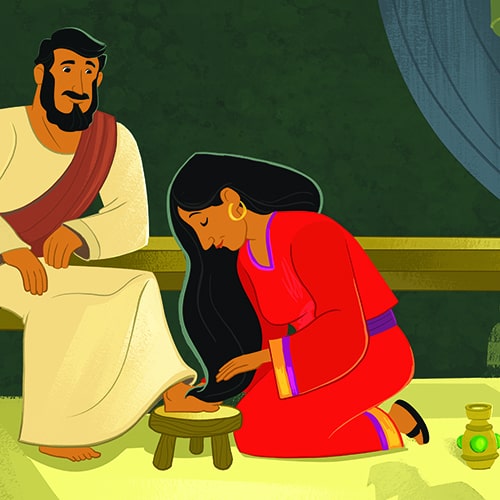Mary Anointing Jesus’ Feet
 The story of Mary Anointing Jesus’ Feet, found in John 12:1-8, is a familiar and deeply beautiful story of Mary’s devotion to Jesus at a crucial time in His life. John places this event shortly after the raising of Lazarus (John 11) and the day before the Triumphal Entry (12:12). Certainly John intended for this story to point forward to Jesus’ soon-coming death, even while affirming Mary’s unashamed love for Jesus. John, perhaps more than any other, would emphasize love for Jesus and love for one another in his writings. This story brings together the reality and significance of Jesus’ impending death with the power and beauty of Mary’s love for her Master.
The story of Mary Anointing Jesus’ Feet, found in John 12:1-8, is a familiar and deeply beautiful story of Mary’s devotion to Jesus at a crucial time in His life. John places this event shortly after the raising of Lazarus (John 11) and the day before the Triumphal Entry (12:12). Certainly John intended for this story to point forward to Jesus’ soon-coming death, even while affirming Mary’s unashamed love for Jesus. John, perhaps more than any other, would emphasize love for Jesus and love for one another in his writings. This story brings together the reality and significance of Jesus’ impending death with the power and beauty of Mary’s love for her Master.
What Happened
Following the raising of Lazarus, the desire to kill Jesus among the religious leaders increased so much that Jesus “no longer walked openly among the Jews but departed from there to the countryside…” (11:54). Jesus had intended to “poke the bear” by raising Lazarus from the dead, but it wasn’t quite time to die. He needed to be careful. As the Passover week approached, however, Jesus again began moving toward Jerusalem with the intent of becoming the ultimate Passover sacrifice. Bethany, the hometown of Lazarus, was one of His stops on the way to Jerusalem.
We don’t know much about Lazarus and his sisters, Mary and Martha, but they clearly were friends of Jesus. Luke records a brief account about Jesus staying with the family earlier in His ministry (Luke 10:38-42). It’s in Luke’s story that we see Martha unhappy that Mary was sitting at the feet of Jesus “listening to what He said” (Luke 10:39). Mary’s determination to learn from Jesus placed her in conflict with long-standing expectations about how men and women are to relate. To sit at Jesus’ feet was to place herself in a position of a student to a Rabbi. This was a role for men alone. Jesus, however, affirmed Mary’s desire to learn from Him. We shouldn’t interpret Mary’s actions as an act of modern feminism. She was merely wanting to learn from this great teacher and didn’t care what others thought about it.
John notes that while Jesus and His disciples were in Bethany, “they gave a dinner for Him there” (12:2). John is careful to point out that “Lazarus was one of those reclining at the table with Him” (12:2). This is important because Lazarus has also become a problem for the religious leaders. Here was a man who’s every breath was a testimony to the life-giving power of Jesus. In fact, “the chief priests decided to kill Lazarus also because he was the reason many of the Jews were deserting them and believing in Jesus” (12:10-11).
Now, just days before his crucifixion, the same Mary who was so determined to learn from Jesus in Luke 10 is just as determined to express her devotion to Jesus at significant personal expense in John 12. At one point during the meal, Mary entered the room. She broke an alabaster jar of expensive perfume and poured its contents on Jesus’ feet, then wiped them with her hair as an expression of her love and devotion to Jesus. The story of Mary anointing Jesus’ feet is deeply personal and suggests that John witnessed the event and its power himself.
As in Luke 10, Mary is not concerned about what others might think. Judas, we are told (12:4), complained that the perfume could have been sold and the money given to the poor. John also notes that Judas was not genuinely concerned about the poor, but was “a thief” (12:6) and saw this as an opportunity to line his own pocket. And again, as in Luke 10, Jesus affirms Mary’s actions… “Leave her alone; she has kept it for the day of My burial” (12:7).
It’s not likely that anyone at that time (other than Jesus) understood what would soon be happening or why. However, it would be easy for anyone close to Jesus, including Mary, to see that things were changing as He approached Jerusalem. Jesus was more confrontational with the Jewish leadership than normal. He was more candid about His own death (even though they didn’t understand His comments). He seemed to be ignoring the real dangers that existed. Something was different, but none of Jesus’ followers fully understood what it was. It was in the midst of this crazy and confusing week that Mary paused to demonstrate her simple devotion to Jesus. Perhaps it was BECAUSE of the crazy and confusing week that Mary felt the need to do SOMETHING.
Perhaps Mary sensed that things would soon be changing drastically and this might be her last opportunity to express her devotion to Jesus. With no concern for the cost of the perfume or what the others might think, Mary intrudes on the meal and assumes the position of the most humble servant. Only the lowliest of a household slave would take on the task of bathing a person’s feet. (See John 13 and what Jesus has to say about washing the feet of His disciples just one chapter later.)
We can’t say for sure what Mary understood about the events that would unfold in just the next few days. What is apparent is that her sacrifice was costly. John makes the point that the oil was “pure and expensive nard” (12:3). Judas estimates its value to be “300 denarii” (12:5). It would be easy to suggest that Mary’s gift was extravagant. What did it accomplish beyond an expression of her love and devotion to Jesus? Nothing really. And that’s the point. Jesus is worthy of that kind of extravagant devotion that serves no purpose beyond lavishing Him with praise and love.
Mary’s act of devotion also demonstrated a level of familiarity with Jesus Himself. For a woman to take down her hair was not something a woman was to do in public. But, Jesus was a friend of the family. Jesus had dined in their home at least once before. Jesus had comforted both Mary and Martha when Lazarus had died. Then He miraculously raised Lazarus from the dead! Jesus was not a distant stranger. He was a close friend and, essentially, a family member.
We must resist any temptation to interpret their relationship as being romantic in any sense. John gives no indication that such was the case. Here is a woman who had grown to love Jesus as a friend, teacher, and family member. Her devotion to Jesus was as “pure” as the oil she used to anoint His feet (12:3). There is probably no greater single act of love for Jesus recorded in all of the New Testament than the story of Mary Anointing Jesus’ Feet here in John 12.
Jesus is, of course, well aware that His death and burial are mere days away. Whatever Mary might have understood about the next week, Jesus uses her simple act of love to point forward to His crucifixion… “she has kept it for the day of my burial” (12:7). Jesus’ death has now become the defining theme of all that is happening in John’s Gospel.
Devotion and Death Are Both in the Story of Mary Anointing Jesus’ Feet
It is important to see how this story combines both the simple devotion of Mary with the impending death of Jesus. Jesus might have been nothing more than a great teacher and prophet. As such He would have done great things and acquired a great following. People near to Him, like Mary of Bethany, would have grown to love Him and show Him great devotion. But a great teacher alone could not have been our Savior. On the other hand, Jesus’ death on the cross as the ultimate Passover sacrifice was a supreme act of love for people like you, and me, and Mary. Such loves calls for great devotion.
Jesus had to die in order to become “the Lamb of God, who takes away the sin of the world!” (John 1:29). Mary’s extravagant act of devotion demonstrated her great love for Jesus. Jesus’ grueling sacrifice demonstrated His great love for us. The whole gospel of Jesus Christ declares that Jesus died for our sins, and then it calls for our loving devotion.
What’s Going On Here?
Jesus was just days away from “the Passover,” which means He knew He was in the final days of His life. As we saw in the story of Zacchaeus, Jesus was managing His time carefully so He could arrange to die precisely on the Passover. Much would happen in the coming week. It would have been a confusing and challenging time for Jesus’ followers. They often failed to grasp what Jesus was talking about and this uncertainty would become more intense as they moved toward the cross. We have the advantage of seeing it all from this side of the cross with help from the Gospels. Still, we have to confess that we are often like the disciples in failing to grasp the Lord’s message and mission. Like them, we sometimes wonder, “What’s going on here?”
Sometimes we can get frustrated by this lack of understanding. The theological issues confronting us when we study the crucifixion and resurrection are significant and heavy. But, we don’t need to be discouraged when we come face to face with our lack of understanding. We are not alone. Mary of Bethany is a good example of someone who didn’t fully understand what was happening around her in the life and ministry of Jesus, but what she lacked in theological understanding, she made up for in simple devotion. Mary demonstrated a love for Jesus that took priority over all other concerns. We need to share this level of devotion, even when we don’t understand. Sometimes our acts of devotion toward Jesus can have an impact beyond our intention. Such was the case with Mary. Her beautiful expression of love became a signpost to Jesus’ death.
You can find all of the activities related to the story of Mary anointing Jesus’ feet here.



